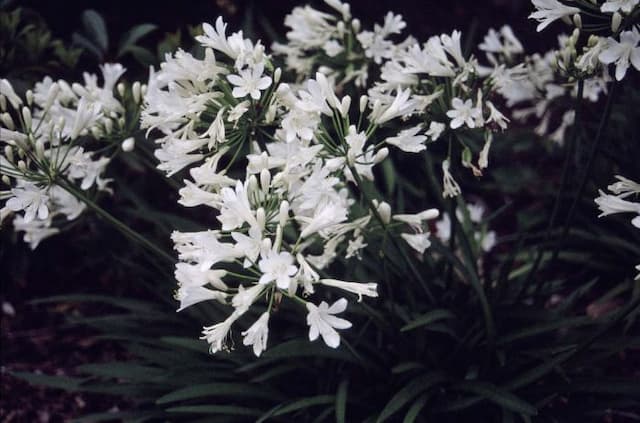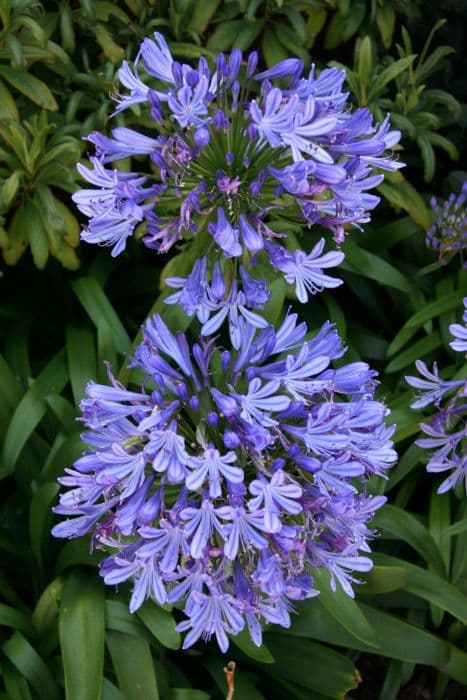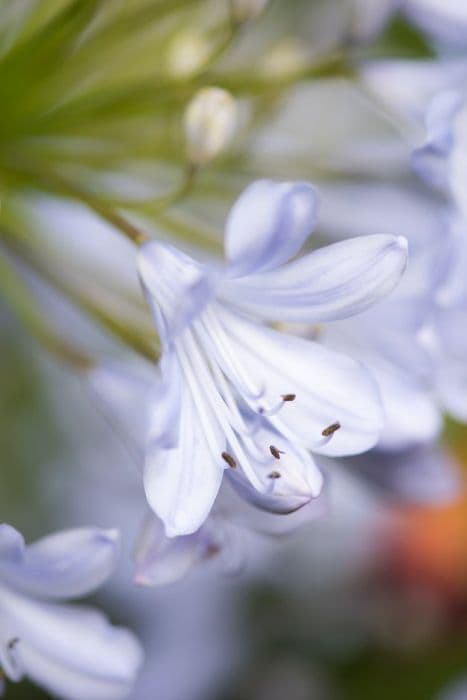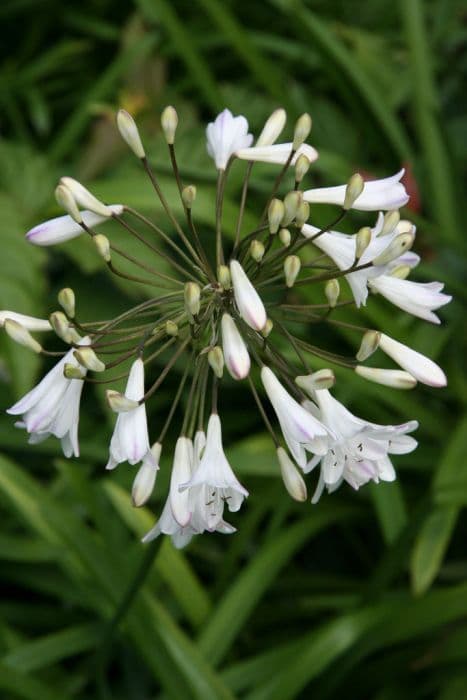Lily of the Nile Agapanthus 'Polar Ice'

ABOUT
The Agapanthus 'Polar Ice', also known as Lily of the Nile, features striking foliage and blooms that are highly decorative. The plant has long, arching, glossy green leaves that form an attractive clump, providing an elegant and lush appearance even when the plant is not in flower. The foliage forms a perfect backdrop for the plant's most impressive feature: its blooms. The flowers of the Agapanthus 'Polar Ice' emerge on tall, upright stalks that rise above the foliage. The blooms are large, rounded clusters of individual trumpet-shaped flowers, each one a delicate shade of white with a hint of blue at the base, giving a cool, icy appearance. The overall effect is a beautiful, rounded globe of flowers that catch the eye and provide a dramatic visual impact in any garden setting. These superb globes of flowers typically bloom in the summer, offering a long season of interest as they slowly open and mature. The blooms are not only beautiful to look at but are also attractive to pollinators like bees and butterflies, adding to the plant's environmental value. The Agapanthus 'Polar Ice' is a popular choice for adding a touch of elegance to borders, beds, and as a focal point in container gardens. Its graceful, cool-hued flowers lend a touch of serenity and are often used in cut flower arrangements.
About this plant
 Names
NamesFamily
Amaryllidaceae
Synonyms
Lily of the Nile, African Lily, Polar Ice Agapanthus
Common names
Agapanthus 'Polar Ice'.
 Toxicity
ToxicityTo humans
The plant commonly known as Lily of the Nile is not highly toxic to humans, but it may cause some mild symptoms if ingested. Possible symptoms could include nausea, vomiting, and diarrhea. In some cases, skin contact with the sap can result in irritation or dermatitis. Therefore, while not severely poisonous, it is advisable to handle Lily of the Nile with care and avoid ingesting any part of the plant.
To pets
Lily of the Nile can be toxic to pets if ingested, particularly to cats and dogs. Symptoms of poisoning in pets can include nausea, vomiting, and diarrhea. In severe cases, pets might experience tremors or cardiac arrhythmia. It is crucial to keep this plant out of reach of pets and seek veterinary attention immediately if you suspect your pet has ingested any part of Lily of the Nile.
 Characteristics
CharacteristicsLife cycle
Perennials
Foliage type
Evergreen
Color of leaves
Green
Flower color
White
Height
2 feet [60 cm]
Spread
2 feet [60 cm]
Plant type
Bulb
Hardiness zones
8
Native area
South Africa
Benefits
 General Benefits
General Benefits- Ornamental Appeal: Agapanthus 'Polar Ice', commonly known as Lily of the Nile, features attractive white flowers that enhance the aesthetic of gardens and landscapes.
- Drought Tolerance: Once established, it requires minimal watering, making it suitable for xeriscaping or regions with water restrictions.
- Low Maintenance: It requires minimal upkeep beyond occasional deadheading and dividing, making it an easy plant for gardeners of all levels.
- Long Blooming Period: It offers a prolonged blooming season, often from early to late summer.
- Attracts Pollinators: The flowers attract beneficial pollinators like bees, butterflies, and hummingbirds.
- Deer and Rabbit Resistance: The plant is generally resistant to browsing by deer and rabbits, reducing the need for protective measures.
- Adaptability: It can adapt to a range of soil conditions, although it prefers well-draining soil and full sun to partial shade exposure.
- Versatility in Landscaping: Suitable for use in borders, containers, and as cut flowers due to its tall, striking flower stalks.
 Medical Properties
Medical PropertiesThis plant is not used for medical purposes.
 Air-purifying Qualities
Air-purifying QualitiesThis plant is not specifically known for air purifying qualities.
 Other Uses
Other Uses- Agapanthus 'Polar Ice' can be used as a natural dye source. The flowers can be processed to make a blue or purple dye for fabrics and crafts.
- The sturdy leaf blades of the Agapanthus can be utilized in basket-weaving or crafting small decorative items, when dried properly.
- When in bloom, Agapanthus can serve as a living privacy screen on patios or in gardens, due to their height and dense foliage.
- The seed pods of Agapanthus can be used in dried floral arrangements, providing an interesting texture and shape to the arrangement.
- Agapanthus can be part of a sensory garden, as the plant has a distinctive foliage texture and the flowers have a subtle fragrance.
- The strong, flexible leaves can be used in the creation of temporary garden ties or natural twine for staking other plants.
- During blossoming season, Agapanthus can be planted to provide directional cues in a labyrinth garden due to their definitive structure and height.
- Photographers can use Agapanthus as a picturesque backdrop for portrait photography sessions.
- The plant can be grown in containers on balconies or rooftops in urban settings, bringing a splash of color to grey landscapes.
- Agapanthus flowers can be used in art projects, such as pressing for botanical prints or incorporated into paper making for a decorative touch.
Interesting Facts
 Feng Shui
Feng ShuiThe Agapanthus, commonly known as African Lily, is not typically associated with Feng Shui practice.
 Zodiac Sign Compitability
Zodiac Sign CompitabilityThe African Lily is not used in astrology practice.
 Plant Symbolism
Plant Symbolism- Love Letters: The common name of Agapanthus 'Polar Ice' is African Lily. Due to its name deriving from the Greek words 'agape' (love) and 'anthos' (flower), African Lilies are often associated with the symbolism of love, sometimes referred to as 'love letters' or 'love flowers'.
- Beauty: African Lily’s striking blue and white flowers are a symbol of beauty and elegance, often used in gardens and bouquets to create a visually appealing aesthetic.
- Endurance: African Lilies are robust plants that can endure various conditions, symbolizing survival, resilience, and the ability to overcome challenges.
- Friendship: The beautiful clusters of flowers can represent networks of friends, thus symbolizing friendship and connections between people.
- Prosperity: The lush growth and abundant blooming of the African Lily can be seen as a symbol of prosperity and good fortune in one's home or life.
 Water
WaterLily of the Nile should be watered deeply and the soil allowed to dry out between waterings. A deep watering might entail using approximately one gallon per plant, every week during active growth in the warmer seasons. In cooler seasons or during periods of rainfall, reduce the watering frequency to every two to three weeks, ensuring the top inch of soil has dried out before adding more water. Overwatering can lead to root rot, so it's essential to ensure good drainage. The total amount of water required can change depending on the climate and weather conditions, so monitoring the soil moisture is key.
 Light
LightLily of the Nile thrives best in full sun to partial shade. Ideally, it should receive at least six hours of direct sunlight each day, promoting healthy growth and abundant flowering. A spot that has morning sun and a bit of afternoon shade would be perfect, especially in areas with intense midday heat. If the plant does not receive enough light, it may not bloom as vigorously.
 Temperature
TemperatureThe Lily of the Nile prefers to grow in temperatures ranging from 50 to 80 degrees Fahrenheit. It can survive minimum temperatures down to about 20 degrees Fahrenheit but will require protection from frosts and freezes. The ideal temperatures for robust growth and blooming fall within the warm end of this range, typically in the 70 to 80-degree range. If temperatures exceed 90 degrees Fahrenheit, providing some afternoon shade can help prevent heat stress.
 Pruning
PruningLily of the Nile requires pruning to remove spent flower stalks and to tidy up any dead or damaged foliage, promoting new growth and maintaining a clean appearance. It's best to prune after the flowering has finished, usually in the fall. Annually, cut back the flower stalks to the base and remove any browned or withered leaves. This encourages the plant to conserve energy for the next blooming cycle.
 Cleaning
CleaningAs needed
 Soil
SoilLily of the Nile thrives in a soil mix that is well-draining, with a mixture of potting soil, compost, and sand or perlite. Aim for a soil pH between 6.0 and 7.0 to keep the plant healthy.
 Repotting
RepottingLily of the Nile should be repotted every 2 to 3 years or when it becomes root-bound. This will ensure the plant continues to grow and flower effectively.
 Humidity & Misting
Humidity & MistingLily of the Nile prefers moderate humidity levels, however, it can tolerate both lower and higher humidity environments as long as it is kept well-watered and has good air circulation.
 Suitable locations
Suitable locationsIndoor
Place Lily of the Nile in bright, indirect light and keep soil moist.
Outdoor
Choose sunny location, water regularly, and protect from freezing temperatures.
Hardiness zone
8-11 USDA
 Life cycle
Life cycleAgapanthus 'Polar Ice', commonly known as Lily of the Nile, begins its life cycle when seeds germinate in spring after a period of moist, cold stratification that breaks their dormancy. As they sprout, they develop into young plants with strap-like leaves, establishing a small clump of foliage at the soil surface. With sufficient water and nutrients, the plant matures over a few years into a larger clump with denser foliage. During each summer, once mature, Lily of the Nile produces tall flower stalks, topped with attractive white flower heads that can attract pollinators and sometimes produce viable seeds. After flowering, the plant goes into a period of dormancy in the colder months, where it might die back slightly but typically remains evergreen in milder climates. The plant will re-emerge and continue this annual cycle, with clumps expanding over time through both seed dispersal and vegetative propagation via division of the root system.
 Propogation
PropogationPropogation time
Spring to early summer
Agapanthus 'Polar Ice', commonly known as Lily of the Nile, is most commonly propagated by division, a method typically undertaken in the spring or early summer. The process involves gently digging up the plant and separating the clumps of rhizomes or root balls into smaller sections, ensuring that each new section has at least one or two growing points or shoots. These divided sections can then be replanted in well-draining soil, spaced approximately 12 to 18 inches (30 to 45 centimeters) apart, to allow for ample growth. Water the newly planted divisions thoroughly. This method ensures that the distinctive traits of 'Polar Ice' are maintained, and the plants will usually flower the following season.




![African lily [Blue Storm]](/_next/image?url=https%3A%2F%2Fplants-admin.emdemapps.com%2Fimages%2Fplants%2F%2Fimages%2F604b63200a08b.png&w=640&q=75)




